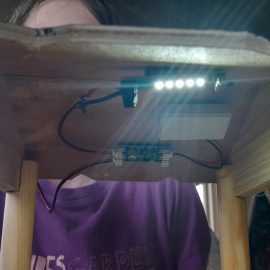
What a summer to be fitting solar panels. It. Rains. All. The. Time. It seems. Or in any case it rains whenever we have people available to do the work.
Since we can’t fit our panel we think about how the electricity will get from the panel to the battery for storing. We know that we need to add something that 1) feeds our battery only as many volts and amps it is capable of swallowing and 2) stops our battery from trying to charge the solar panel when there are more volts and amps available in the battery than what is coming from the panel. In the panel as in the battery there are all kinds of chemical and electrical processes going on, but none of it is smart. A charge controller is like the brains of the operation: it ‘knows’ which way electricity should flow and how much is too much.
What do we need to know to choose the right one? First, it has to match the voltage rate of our system. This is easy – ours is a 12V system. Second, it has to be able to handle the maximum load coming from our panel (the Watt Peak, see ‘Day 11’). We know this to be 410 watts. Charge regulators are rated in amps (A) and the calculation for finding the amps required for any battery/panel combination is this:
Solar Panel Power / Battery charging voltage = Charge regulator minimum capacity
The charging voltage is the voltage that the battery has when it’s fully charged (as well as the maximum volts you should be putting into it when it’s charging fast). That’s not 12V! It’s always more, often as much as 14.4V. That’s what it is in our case, we learn from the manufacturer’s website. So our regulator needs to be able to handle…
410 W / 14.4 V = 28.43 A
In other words, a 30A controller should do.
Solar Stu recommends an MPPT solar charge controller.
“MPPT stands for -?”
“Maximum Power Point Tracking”.
Hold on, this is something we learned at our solar workshop in May! The charge controllers on our Mini-Steves were of this kind.
All we have to do is to dig out the notes for our workshop. They say in a box titled ‘Extra for Experts!’: “The charge regulator you have is a very advanced bit of kit. It’s called a Maximum Power Point Tracking controller (MPPT). This is just like the modern controller used in houses that have solar power fitted! It modifies the volts and amps coming from the panel to optimally charge the battery depending on how flat or charged it is and also on how much light there is.”
Sold. We need brains for this operation.
Now that we’ve got our charge controlled, we just have to wait out the weather…


